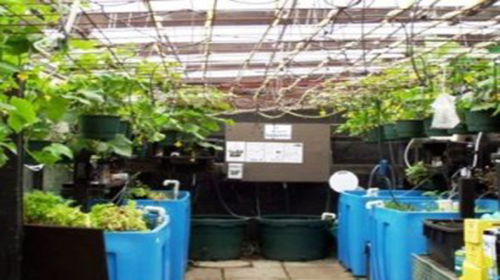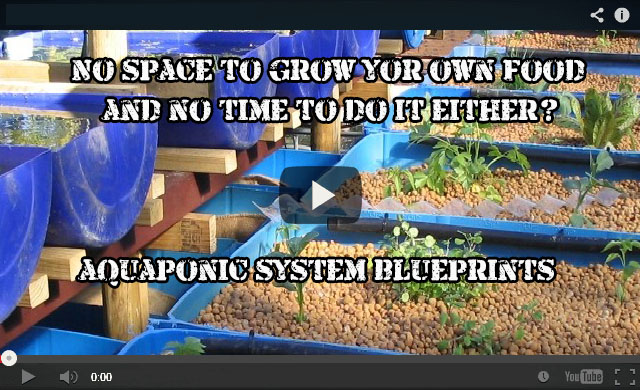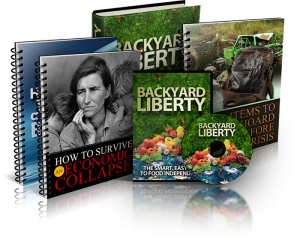When it comes to disaster preparation there is really no such thing as being too ready for any situation. The fact is, however, that no matter how much food you’re storing, it won’t be enough to feed yourself and your family forever.

Eventually you’ll need to find an outside source of food to provide enough nutrients to survive on indefinitely. While the obvious answer is to grow and hunt for food until civilization can reemerge, that may not always be possible. What if the emergency has rendered the soil unusable or the emergency is a famine. In addition, growing and even hunting for food can be much more difficult and even dangerous in the winters.
One solution to consider is a fairly new concept known as aquaponics. It combines the benefits of aquaculture and hydroponics. In addition, it eliminates or greatly reduces all the problems associated with either of these systems individually. First, look at what each of these systems are to get a better understanding of how aquaponics will work.
- Aquaculture – Also known as aqua farming, it is the process of growing aquatic organisms for food. This can include fish, crustaceans, mollusks and even aquatic plants. Using large indoor ponds it is possible to grow a sufficient amount of protein-rich fish and other aquatic organisms to survive on. The problem, however, is you need to feed the fish and other animals, and get rid of the waste to ensure they are able to thrive in the healthy water.
- Hydroponics – This is a process of growing plants in a mineral nutrient solution based in water rather than soil. The roots of the plants can be placed directly in the water, or in another inert medium like gravel, mineral wood, clay or other items. The problem with hydroponics is that you need to continuously resupply the nutrients for the plants to grow.
Aquaponics: The Best of Both Worlds
The problems associated with aquaculture and hydroponics are actually opposite issues, and when combined they cancel each other out. Using the plants to feed the fish in the water, for example, you eliminate the need to constantly provide an external source of food for the aquatic organisms to survive on. The waste produced by the fish will settle down to the bottom, creating a nutrient rich substance which can be removed and used as food for the plants.
In order for this system to be successful it is important to find aquatic organisms which can survive only on plant life. Tilapia, a very common warm-water fish which can grow quite quickly will work perfectly in this situation. Tilapia can eat both plants and animals, which makes them perfect for this process. They grow fairly quickly, taking only about eight months to get to the point where they can be harvested. Since there aren’t going to be any predators living in the ponds (until you get hungry), these fish can rapidly reproduce and create a sustainable source of food which will provide all the protein and many other nutrients needed to survive indefinitely.
There are many different plants which can work in this type of system, but one of the best is called duckweed. This is an extremely fast growing plant which can do very well growing without soil. In ideal situations duckweed can double in weight in just 24 hours, providing the fish living beneath with all the food they can eat. In addition, duckweed is a healthy green plant for people to eat as well. It can replace or supplement lettuce, spinach or any number of other green vegetables for a variety of great nutrients.
Creating & Managing a Aquaponics System
There are guides available to follow for creating an aquaponics system right in your own home. The only things that are required are containers large enough to hold the number of fish you’re looking to grow and the initial stock of the fish and plants which will be used. Placing these items near sunlight is ideal so there is no need for artificial lighting systems, and it will further eliminate any need for outside power to keep this system running.
Once the initial system is set up, you simply need to take the time to remove the waste water from the bottom of the containers where the fish are living, and apply it to whatever is holding the roots of the plants. Having the plants growing in the fish water itself can be a great way to further reduce the amount of work needed to keep this system going. Remember, however, it will take about a year before the system is fully up and running, so this isn’t going to be an immediate solution in the event of an emergency.
Consider starting this system in your home today so you can enjoy food that is virtually free now, and you’ll be ready for any type of emergency in the future. Even a famine which causes massive food shortages everywhere else in the world will not be a concern when you have the fish and duckweed to survive on. As with most preparation activities, this is something that you can start out on a fairly small level and scale up over time. Since this is a largely closed loop system, there isn’t too much work involved, or any real investments of money after the initial setup.
Remember, you can experiment with other types of aquatic organisms and other plants as well to create a more diverse food source. This is a great way to get prepared for any situation which causes a food shortage, and can be fun as well. Consider starting your own aquaponics system in your home, garage or other location and let us know how it works!
Click the picture for more information about aquaponics!
What to read next:
DIFFERENT COMPOST MAKING TECHNIQUES (AND THE ADVANTAGES OF EACH)
STORE VEGGIES FOR LONG TERM STEP-BY-STEP
HOW TO PLANT A QUICK AND EASY GARDEN IN BAGS OF SOIL WITHOUT DIGGING
WATERING TOMATOES: WHEN & HOW – 5 PRO TIPS
HOW TO GROW TRUFFLES IN 7 EASY STEPS AND MAKE A BIG PROFIT
HOW TO BUILD AN INDOOR HYDROPONIC VEGETABLE GARDEN
Want to be as self-sufficient as possible? Want to master all the lost skills our grandfathers had? Then you really need this amazing step-by-step guide. It is called The Lost Ways and it contains all the knowledge of our forefathers.
Here’s just a glimpse of what you’ll find in The Lost Ways:
From Ruff Simons, an old west history expert and former deputy, you’ll learn the techniques and methods used by the wise sheriffs from the frontiers to defend an entire village despite being outnumbered and outgunned by gangs of robbers and bandits, and how you can use their wisdom to defend your home against looters when you’ll be surrounded.
Native American ERIK BAINBRIDGE – who took part in the reconstruction of the native village of Kule Loklo in California, will show you how Native Americans build the subterranean roundhouse, an underground house that today will serve you as a storm shelter, a perfectly camouflaged hideout, or a bunker. It can easily shelter three to four families, so how will you feel if, when all hell breaks loose, you’ll be able to call all your loved ones and offer them guidance and shelter? Besides that, the subterranean roundhouse makes an awesome root cellar where you can keep all your food and water reserves year-round.
From Shannon Azares you’ll learn how sailors from the XVII century preserved water in their ships for months on end, even years and how you can use this method to preserve clean water for your family cost-free.
Mike Searson – who is a Firearm and Old West history expert – will show you what to do when there is no more ammo to be had, how people who wandered the West managed to hunt eight deer with six bullets, and why their supply of ammo never ran out. Remember the panic buying in the first half of 2013? That was nothing compared to what’s going to precede the collapse.
From Susan Morrow, an ex-science teacher and chemist, you’ll master “The Art of Poultice.” She says, “If you really explore the ingredients from which our forefathers made poultices, you’ll be totally surprised by the similarities with modern medicines.” Well…how would you feel in a crisis to be the only one from the group knowledgeable about this lost skill? When there are no more antibiotics, people will turn to you to save their ill children’s lives.
And believe it or not, this is not all…
Table Of Contents:
Making Your Own Beverages: Beer to Stronger Stuff
Ginger Beer: Making Soda the Old Fashioned Way
How North American Indians and Early Pioneers Made Pemmican
Spycraft: Military Correspondence During The 1700’s to 1900’s
Wild West Guns for SHTF and a Guide to Rolling Your Own Ammo
How Our Forefathers Built Their Sawmills, Grain Mills,and Stamping Mills
How Our Ancestors Made Herbal Poultice to Heal Their Wounds
What Our Ancestors Were Foraging For? or How to Wildcraft Your Table
How Our Ancestors Navigated Without Using a GPS System
How Our Forefathers Made Knives
How Our Forefathers Made Snow shoes for Survival
How North California Native Americans Built Their Semi-subterranean Roundhouses
Our Ancestors’Guide to Root Cellars
Good Old Fashioned Cooking on an Open Flame
Learning from Our Ancestors How to Preserve Water
Learning from Our Ancestors How to Take Care of Our Hygiene When There Isn’t Anything to Buy
How and Why I Prefer to Make Soap with Modern Ingredients
Temporarily Installing a Wood-Burning Stove during Emergencies
Making Traditional and Survival Bark Bread…….
Trapping in Winter for Beaver and Muskrat Just like Our Forefathers Did
How to Make a Smokehouse and Smoke Fish
Survival Lessons From The Donner Party
Get your paperback copy HERE
CHECK OUR survival and prepping solutions
If you found this article useful, please like our Facebook page and stay up to date with the latest articles.



